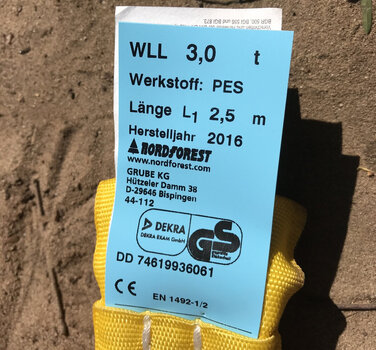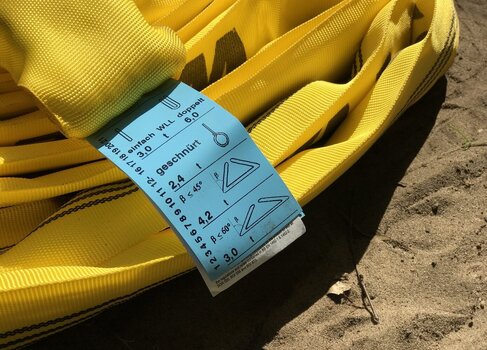This did cost me 363 € including 21% VAT. I ordered it together with my car in September 2022. I guess prices have risen.
General statement: You can consider each properly tested and marked equipment as equal safe to use, if it is not damaged and used properly. In this case, all equipment is safe. Problems arise on the car side, on unseen damage of equipment and miss-use. Everybody can by a 12 t truck and start a recovery with 12 t on the rope without a proper education. That's where things get worse.
1. It is not marked properly. If I interpret the word "Breakstrain" right, it is the breaking load of that gear. That should not be noted on recovery gear. You only can assume that the safety factor is 1:2 which leads to 5,5 and 6 t working load limit (WLL), respectively. The problem is, that untrained people tend to see the breaking load as the limit, they can use. So 8 t (even if that is not reached) is fine! The thing is, exceeding the WLL once, reduces the breaking load to an unknown value somewhat lower that 11 t or 12 t. And no one knows what the new breaking load is. That also shifts the WLL and everytime the new lowered WLL is exceeded that process continues until the rope breaks.
It is a safety factor only to note the WLL. The safety margin, breaking limit etc. is completely uninteresting. But manufacturers tend to print the braking load onto their gear, as these are higher numbwers, suggesting stronger gear. That is simply wrong.
Do the ropes show pictures on how they can be used and how the WLL will be affected? If not, how will you know? That is an important information. See the pictures. That is a proper mark which shows the usage and the effect on the WLL (BTW, if that mark is lost, you must discard such a rope in professional use in Germany).


Prices: a propely marked rope with FTF 6 (FTF is a mark, that improves the WLL mark as the customer doesn't have to calculate anymore and 6 means taht this is suitable for a 6 t winch in any possible use case): 17,90 Euro inkl. VAT. In 4 m 32 Euro inkl. VAT. These round ropes can be used on trees, Three of them and you're fine: 96 Euros inkl. VAT
2. I do not like the friction pulley because if plastic winch ropes don't like one thing then this is heat and friction. Yes, they do work. Yes, people measured the temperature, it inceased and didn't kill the rope. But why accept that, when there are frictionless solutions which in additon offer a bigger radius, as well. While a steel rope resists too small radiuses, plastic ropes don't. The smaller the radius, the more load has to be taken by the outer fibers and thereby by less fibers. If I buy a car for thousands of Euros but do not spend money for the best and safest recovery equipment the proportionality is wrong, in my opinion.
3. Can't read what is written on the steel shackles, but they seem to be somewhat small? What are they for? Good and fine steel shackles with a 6.75 t WLL, under 10 Euros.
4. Same as under 1 for the soft shackles. Not properly marked from what I can recon. Same applies here, if not properly educated, people may use soft shackles on sharp edges or too small radiuses. A propber makr won't help here, of course. They would be fine for me if the user knows how to use them and if they were marked properly. Good is the heat and friction insulation. Soft shackles tend to be expensive. A FTF 2,5 t is up to 50 Euros. I add 80 Euros for each. I know all the discussions about safety regarding steel and soft shackles (things flying areound, blabla) and we discussed that with professional experts in ground based recovery (see below) many times and the conclusion was very clear: steel shackles are more secure because they are easy to handle and you can see immediately, if they have been damaged. That is not the case with soft shackles. Of course, if you use them in the correct way and if has not an unsees damage, they are as secure as steel shackles.
Background of my opinion: We offered offroad trainings including what material do you need for a safe recovery ourselves for customers. The part of safe recovery was created and held by a head forester from the Black Forest. He is responsible for all ground based recovery gear (4x4 recovery falls into that category) and lifting gear. He educates his people in the proper use and he is also responsibe for checking that gear and dispose it, if necessary. He is involved in development and test of equipment on the recovery gear manufacturer site and got involved by emergency services in his region, when tricky recoveries needs to be done (like loaded trucks which sunk down to their ladder frame in soft lime powder). I participated in his workshops often, and learned.
@emax
If interested, I can give a small workshop in recovery equipment at the D-A-C-H Grenadie meet up in October. I use the content of my teachers training.
AWo

 www.4x4works.co.uk
www.4x4works.co.uk

 www.4x4works.co.uk
www.4x4works.co.uk









